WHAT'S NEW:
Eruption Confirmed!
New lava (rumbleometer stuck in flow) SE rift zone
(posted 9/1/98)
BACKGROUND:
Technology (ROV, ships, etc.)
Other 1998 Axial cruise reports
EXPEDITION:
Science Objectives
Calendar
Today's Science News
Participant Perspective
Teacher Logbook
EDUCATION:
Curriculum
Teacher Observations
Questions/Answers from sea
MULTIMEDIA:
(video clips, animations, sounds)
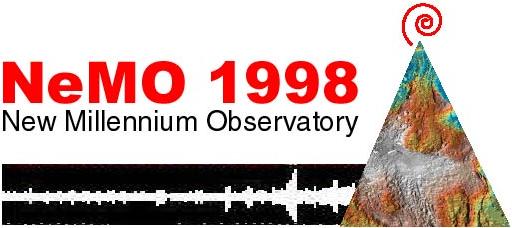
Logbook
September 3, 1998
September 3, 1998
Contents:
Science Report
September 3, 1998 ROPOS came back on deck this evening after 16 hours on the bottom during dive 464. The dive recovered water and bacteria from the slurp samples, tube worm samples, sulfide samples from Castle vent, and bacterial traps that were deployed on earlier dives.
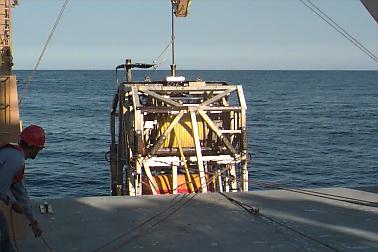 The recovery of the ROV is always an exciting time on the ship because almost
everyone
is out on the fantail of the ship waiting for the cage and vehicle to get
secured so that
they can go and see what treasures ROPOS has brought back to the surface. There
is always a lot of activity on deck as individual investigators get their
samples and start
working with them in the lab.
The recovery of the ROV is always an exciting time on the ship because almost
everyone
is out on the fantail of the ship waiting for the cage and vehicle to get
secured so that
they can go and see what treasures ROPOS has brought back to the surface. There
is always a lot of activity on deck as individual investigators get their
samples and start
working with them in the lab.
After 9 hours of CTD's (photo of CTD instrument) and rock cores (photo of rockcore sample), ROPOS is now on it's way down to the bottom again, this time about 3 miles south of all our previous dives - a location of the south rift zone where a bathymetric resurvey collected in May showed depth changes (map of bathymetry difference) up to 25 meters from earlier surveys. We think there is more new lava there and we're going down to find out for sure. We'll let you know...
Listing of all Science News postings
Life at Sea: Participant Perspective
Kim Juniper
University of Quebec
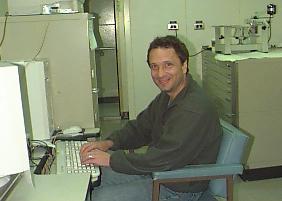
This guy is Kim Juniper, a professor in the GEOTOP Research Centre at the University of Quebec in Montreal, Canada. Together with my friends and colleagues Steve Scott and Verena Tunnicliffe, who are also out here at Axial Volcano, I am celebrating my 15th year of hydrothermal vent research. We are at the spot where it all began in August 1983 when we made the first discovery of deep sea vents in the North Pacific Ocean using the manned submersible Pisces IV. That was the summer that I got hooked on hot vents. Just a few months before I had finished a PhD in New Zealand and moved back to Canada for a two year fellowship at the Institute of Ocean Sciences in Sidney, British Columbia. There I was using the Pisces IV submersible to study bacterial growth in an local fjord. One thing led to another and I found myself with a last minute invitation to join the CASM (Canadian-American SeaMount) expedition to look for hot vents on the Juan de Fuca Ridge. We were lucky enough to find what we were after and I've been doing this ever since.
I have a hard time categorizing what kind of research I do because I'm interested in many things and don't pay too much attention to traditional boundaries between different branches of science. I was trained as a marine microbial ecologist, someone who studies the ecology of bacteria and other microorganisms in the marine environment. However, I don't usually get too excited about studying just bacteria.
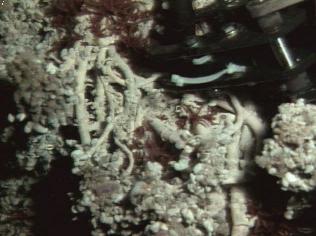 BACTERIA AS MENU ITEMS
BACTERIA AS MENU ITEMS
RUSTY FLUFF
Another one of my favorite areas of research is to look at how microbes interact
with minerals. Hydrothermal vents are very important areas for the formation of
mineral deposits. Out here at Axial Volcano I am trying to understand how 'iron
bacteria' help form coatings of 'rusty fluff' of iron oxide that we are seeing
everywhere on the new lavas from last winter's eruption. Iron bacteria create
energy for growth by transforming dissolved iron into rust. The rust or iron
oxide mixes with bacterial slime to form a coating on the outside of their
cells. I started studying iron bugs back in 1988, working with a French
colleague on fossil bacteria in rocks called cherts which are very rich in iron
oxide. These rocks came from mines in Cypress and the Phillipines and California
where sulfide ores formed at hot vents on the floor of ancient oceans are being
extracted for metals such as copper, lead, zinc and silver. That project got me
interested in iron bacteria but I could never find a place in today's ocean to
do more work on the subject. Then, in 1993 we used ROPOS to visit a fresh
eruption just to the north of Axial Volcano and low and behold there were 'mats'
of iron bacteria in some of the crevices on the new lava flow. We scooped up
samples to analyze and used video to map where the mats were found on the
seafloor. The analyses showed that the mats were a lot like the stuff that I had
been seeing in the fossils. Filaments of bacteria coated with an inside layer of
iron and an outside layer of silica. In the past 10 days we have been seeing
dustings of this same rusty fluff all over the new lava,
 to the point where it
was hard to tell the difference between new lavas which are usually shiny and
black, and older ones which have a coating of sediment formed by the slow
accumulation of plankton debris. I am working with the geologists and other
microbiologists on the ship to try and figure out how so much of this rusty
fluff could have formed so quickly. That means collecting samples of the stuff,
and trying to figure out where all the iron could have come from to make it.
Ideas are flowing as fast and freely as the discoveries we are making during the
dives. Just when we think we've got it nailed, we see something new and off we
go back to the drawing board. But we are getting closer to an answer, thanks in
part to the fact that we can all participate in the dives by watching the video
feed from the ROPOS cameras. Having a room full of experts in geology and
biology all looking at the same thing really cuts down on the "I wonder what
that is" time.
to the point where it
was hard to tell the difference between new lavas which are usually shiny and
black, and older ones which have a coating of sediment formed by the slow
accumulation of plankton debris. I am working with the geologists and other
microbiologists on the ship to try and figure out how so much of this rusty
fluff could have formed so quickly. That means collecting samples of the stuff,
and trying to figure out where all the iron could have come from to make it.
Ideas are flowing as fast and freely as the discoveries we are making during the
dives. Just when we think we've got it nailed, we see something new and off we
go back to the drawing board. But we are getting closer to an answer, thanks in
part to the fact that we can all participate in the dives by watching the video
feed from the ROPOS cameras. Having a room full of experts in geology and
biology all looking at the same thing really cuts down on the "I wonder what
that is" time.
Kim Juniper
Listing of all Perspectives postings
Teacher At Sea Logbook
September 3- 0800 hours
 |
Scientists swarm to ROPOS as soon as it comes back aboard to recover their samples. (photo: ROPOS NeMO 1998) |
Overnight scientists found good evidence of yet another new lava flow on the sea floor. As compelling as the evidence is, scientists are still seeking what they refer to as the "smoking gun." That would be a fresh lava flow complete with hot vents. This would establish an absolute link between the two phenomena. It seems intuitively obvious, but intuition is not proof, and scientists live on proof.
The camera that sits on the ROPOS cage has been acting up again today. Yesterday's cruise ended when the camera stopped functioning altogether. This is the camera that is used to dock ROPOS in the cage at the end of each dive. Without it the technicians must bring the cage and ROPOS close to the surface and perform the docking visually. If the camera continues to perform erratically, this dive will probably be a short one.
1400 hours
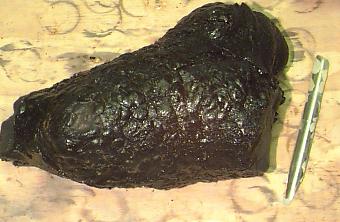 The word on board today is ROCKS!, as in "Rocks Rule!" We have samples of some
of the world's newest ocean floor (photo shows new glassy lava) aboard the R/V Brown. Glassy basalt lavas
that may be less than a year old were brought aboard in the sampling box just
before noon today. Then while running a routine rock core that usually produces
samples the size of sand grains or small pebbles, the line became entangled with
about 250 pounds of ocean floor.
The word on board today is ROCKS!, as in "Rocks Rule!" We have samples of some
of the world's newest ocean floor (photo shows new glassy lava) aboard the R/V Brown. Glassy basalt lavas
that may be less than a year old were brought aboard in the sampling box just
before noon today. Then while running a routine rock core that usually produces
samples the size of sand grains or small pebbles, the line became entangled with
about 250 pounds of ocean floor.
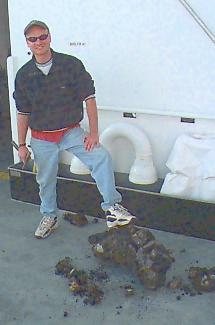
This piece was hauled aboard in one chunk. Geologist John Chadwick is seen in his "ultra-cool" shades displaying his treasure.
Our chief scientist will be doing a piece on these new lava flows and will include pictures taken directly from the seafloor. Check it out for some of the most spectacular geological sights we've seen out here. Basalt Background
In general, basalt lavas contain little or none of the mineral quartz. This makes basalt lava very fluid. As it pours from the tear in the Earth's crust the lava has a tendency to spread out in relatively thin sheets. Of course when it strikes the very cold seawater it cools quickly into basalt glass on its surface. The still molten rock beneath this glassy crust can continue to move, and it is this combination of flowing lavas and glassy crusts that create much of the fantastic geological structures we see near the vent areas. Among these are sheet basalts, lobate flows (pillow lavas) and basalt columns that support thin crusts over areas from which the molten lavas have drained. These thin crusts often collapse creating the cave like structures seen in some of the pictures we are taking on the seafloor.
 The dark color of basalt is due to the presence of metals like iron and
magnesium in this lava. Our scientists are particularly interested in these
very young lava flows because they will be able to see how ocean floor rocks
change over time. It is interesting to learn about all of the tests that are
run on these rock samples. For instance, in one test the rocks are crushed very
fine and melted at high temperature. Scientists then look at the concentration
of the isotopes of gases like helium to give them clues about the origin of the
magmas that formed these flows. As I mentioned in an earlier posting,
scientists aboard this vessel will be looking at the concentrations of certain
rare-earth elements such as samarium and neodymium as well as the ratios of
these elements to other elements in the rocks. Their goal is to support or
refute the idea that Axial seamount is produced by a hot spot has not always
been under the Juan de Fuca Ridge. The westward motion of the Juan de Fuca
Ridge has caused it to ride over the hot spot at this point in time, and we are
seeing the results in Axial seamount. Perhaps some rock brought up by this
expedition will change that whole story. That is the nature of science.
The dark color of basalt is due to the presence of metals like iron and
magnesium in this lava. Our scientists are particularly interested in these
very young lava flows because they will be able to see how ocean floor rocks
change over time. It is interesting to learn about all of the tests that are
run on these rock samples. For instance, in one test the rocks are crushed very
fine and melted at high temperature. Scientists then look at the concentration
of the isotopes of gases like helium to give them clues about the origin of the
magmas that formed these flows. As I mentioned in an earlier posting,
scientists aboard this vessel will be looking at the concentrations of certain
rare-earth elements such as samarium and neodymium as well as the ratios of
these elements to other elements in the rocks. Their goal is to support or
refute the idea that Axial seamount is produced by a hot spot has not always
been under the Juan de Fuca Ridge. The westward motion of the Juan de Fuca
Ridge has caused it to ride over the hot spot at this point in time, and we are
seeing the results in Axial seamount. Perhaps some rock brought up by this
expedition will change that whole story. That is the nature of science.
Repairs on ROPOS are nearing completion. We will soon be heading for the black smokers in the area known as Ashes. You won't want to miss that.
Logbook of all Teacher At Sea postings
Question/Answer of the Day
Send Your Question to NeMO
Back to Calendar